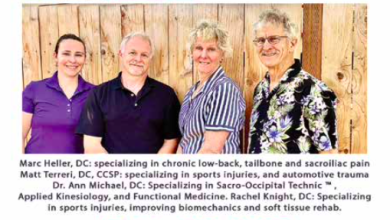In Stiffness and In Health
I have felt stiffness, and I know you have too. What does it mean to feel stiff and/or sore? This is hard to fit in 450 words, so this will just be an overview.
To understand stiffness, we must first understand the “stuff of stiffness”.
Consider that you not only have muscles in your body, but tendons, ligaments and joints too. These tissues are all made up of different types stuff, and therefore react differently to a physical stress being placed on those tissues.
Joints can be a source of stiffness, swelling or tightness. Overuse and even barometric pressure changes (weather) sometimes affect joints.
Ligaments span from one side of a bony joint to the other, while tendons connect muscles to bones.
These tissues can be a source of inflammation and stiffness if they are injured (sprains and strains).
As a clinician it is important to understand not all stiffness is created equal. In addition, because you are made of more than one tissue type healing time will vary depending on which tissues are involved.
Also consider that you – yes you… (pause) age. I know, I know it’s terrible and I said it! But think about this – we can all see the changes on the outside, but what about the inside?
Those tissues I just spoke about age too. They become less stretchy and forgiving as time goes on. They can also take longer to heal.
Case scenario: Your neck is stiff. No amount of stretching and bodywork is helping.
What if the muscle didn’t need to be stretched? What if the muscle is stretched too much already? Consider a rope that is stretched until it almost breaks. If you wanted to loosen it, would you stretch it more, or try to slacken it?
Look at people you see. How many of them carry their head forward compared to their shoulders? In a perfect world an imaginary line goes from your ear to the middle of your shoulder – like a plumb bob.
If your head is being carried too forward those neck muscles in back are stretched to their limits. You can’t make them more slack by rubbing them or stretching them – they already are stretched too much. You need to get the head pulled back over the shoulders to put slack back in those muscles. Stretching the muscles on the opposite side of the neck (the front of the neck and chest) and strengthening the tight muscles in the back is usually the key.
So the next time you feel lingering stiffness just know it might not be so simple, but the good news is you can usually do something about it!
Matt Terreri, DC, CCSP is a sports chiropractor at Southern Oregon Sports & Spine as well as the official chiropractor for the SOU Raiders and a volunteer medical provider for the U.S. Olympics.



